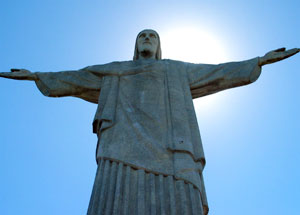RIO DE JANEIRO - For someone who had been to the top of Corcovado "more than 800 times," Rodrassis, our chain-smoking, wise-cracking guide, seemed overly excited about introducing us to Le esta o Crito Redentor, the giant statue of Christ the Redeemer that sits atop the city's largest mountain.
"I never get tired of going up there," said Rodrassis as we boarded the Tram do Corcovado (at a cost of about $12 each) for the 20 minute white-knuckle ride to the summit.
The narrow gauge train slowly pulled out of the station with every uncomfortable wooden seat filled and began its steep climb to Rio's defining landmark - it sits perched 710 metres above this amazingly beautiful city of over 10 million with outstretched arms waiting to embrace visitors.
"The statue is the heart of Rio," said a passionate Rodrassis as the train disappeared into a tropical rain forest, known as Tijuca, that carpets the base of Corcovado. If the statue is Rio's heart, then the Tijuca forest is its lungs.
"This is the largest urban forest in the world," Rodrassis proudly announced. "It is Rio's breath."
The lush green forest, home to some of the rarest animals on earth and over 600 species of birds, certainly takes your breath away. And its size (25 kilometres long and 15 km wide) can only truly be appreciated when you get to the top of Corcovado.
As the train chugged along, Rodrassis filled us with some facts about Rio:
"This was the capital of Brazil until the early 1960s when they moved it to Brasilia ...
"The original name of Rio was Sao Sebastino do Rio de Janeiro and then it was shortened to Rio de Janeiro (River of January) but now everyone simply calls it Rio ...
"Rio is the second largest city in Brazil - only Sao Paulo (which has over 20 million residents) is larger," said Rodrassis with a snarl. (Rio and Sao Paulo are bitter rivals - especially on the soccer pitch - and the industrious people of Sao Paulo take great joy at jabbing the fun-loving inhabitants of Rio, known as Cariocas, and their laid-back beach lifestyle.)
"The people of Sao Paulo say the reason the statue has outstretched arms is because it is waiting for the people of Rio to go to work and then it will bring its hands together and applaud," said Rodrassis with great distain in his voice.
"The statue was designed by a French architect and the head and arms were made in France but the body (torso) was made on the spot," said Rodrassis, returning to his role of guide.
"The statue (it stands 38 metres tall; is made of cement with a limestone covering; took five years to build; and was completed in 1932) is held in great esteem by the people of Rio because everyone contributed money towards its construction - from the poorest slum dweller to the city's richest landowners."
Every so often during our journey, a clearing in the forest would reveal an azure sky that hangs over this city like a permanent canopy. A few hundred metres from the end of our ride, the entire glorious city came into full view - its pristine white beaches, where the water temperature is a constant 23C; its towering office and apartment complexes; its notorious slums and shanty towns that cling to the sides of stone mountains and look out on the crystal clear waters of the southern Atlantic.
"Imagine, slums with a view," I told Rodrassis.
"Only in Rio," he responded.
A short elevator ride completed our journey to the top of Corcovado, where we were welcomed by vultures circling over the great statue's head, searching, Rodrassis told us, "for the carcasses of animals that die in the forest."
It's only when you look out on Rio from Corcovado that you realize what a vertical city this is. Our guide, who was puffing away on yet another cigarette - they cost the equivalent of 30 cents a package here - told us that 85 per cent of Cariocas live in high rise apartments or condominiums and that there are very few houses "unless you count the shacks in the slums," said Rodrassis.


Left: The statue of Christ the Redeemer is the city’s main landmark. Right: The people of Rio are always offering up smiles.
The city spreads out in several directions from Corcovado - to the affluent south, where the rich live in overstated buildings near one of the 23 magnificent beaches with enchanting names like Copacabana, Ipanema and Berra (pronounced baha), and to the poverty-stricken north, where the city's airport is located, and where some of the most economically-depressed people on earth huddle together in makeshift shanty towns and survive on meagre wages from jobs as construction labourers - surprisingly, the poorest paying job in Brazil - and domestic workers. There are even guided tours of one of the slums, known here as favela. The Rocinha favela is the largest slum and has one of the best views of Copacabana and Ipanema beaches. It is the one that offers guided tours.
Wedged between the north and south ends is the city centre, the economic heart of Rio, where it is forbidden to reside and where the world famous Carnival is held each year (this year's event was held Feb. 21-25) on a narrow street lined with stadium seating called the Sambadromo.
The downtown area is ringed by some distinguished buildings, like the ornate opera house in Cine Landia Square that is a replica of Paris' famed Opera Garnier. The square is also home to two of the city's most famous theatres as well as grand statues, a beautiful public library and lots and lots of small cafes. Flamingo Park is located here and adds a touch of
European elegance to this South American beauty. "The people of Rio are very poor - they make an average of $500 U.S. a month - but they are very happy and proud," said Rodrassis, who pleaded with us to follow him to "get a view of the city's most important building."
We were expecting him to point out landmarks like the Cathedral Metropolitana, built in the shape of an Aztec pyramid that features four brilliantly coloured stained glass windows that stretch from floor to ceiling (85 metres) and bathe the remarkable structure - it can hold up to 25,000 people and was built to honour the city's patron saint, St. Sabastien - in a kaleidoscope of colours.
Or Sugar Loaf Mountain, where it takes two thrilling cable car rides to get you to the summit. This is the place where the James Bond movie Moonraker was filmed (remember the silver-mouthed character Jaws biting through the cables and sending the car Bond was riding in to the forest floor below?) - and where young Cariocas gather to disco late into the night (at a club located at the first of two mountains that make up Sugar Loaf.) Like Corcovado, Sugar Loaf provides a jaw dropping gorgeous view of the city.
But no, what Rodrassis wanted us so desperately to see was Rio's Maracana Stadium, the enormous structure built for soccer games and concerts.
"Isn't it beautiful?" Rodrassis asked his visitors as he pointed to an oval building with a hole cut in the roof. "After we leave here, we will visit Maracana. This is a place everyone must visit when they come to Rio."
After a few hurried obligatory photos in front of Christ the Redeemer - with outstretched arms, of course - Rodrassis rounded us up and we headed back down the mountain to a waiting car.
As we sped through the city devoid of traffic, Rodrassis told us that only one in eight Brazilian families actually owns a car.
"I have a Mercedes and a Porsche," said Rodrassis.
"The tourist guide business in Brazil must be very lucrative," I said.
"No," responded the fun-loving guide. "My wife's name is Mercedes (very common in Brazil) and my daughter is called Porsche. For Christmas we bought a cat and we named it Ferrari. Now I have a whole fleet."
Soon we were parked in front of one of the 18 entrances that make up enormous Maracana Stadium, a place regarded as a shrine by the soccer-mad Brazilians. It was built for the 1950 World Cup, the one a downcast Rodrassis informed us Brazil lost to neighbouring Uruguay and that "led to many suicides."
For just $2, you can explore the giant complex that seats 120,000 for soccer but can be expanded to over 200,000 for concerts. In the bowels of the stadium we were met by a player clad in Brazil's national team colours doing tricks with a ball for contributions. Visitors walk in the footsteps of greatness here - literally. In an area dubbed the "walk of fame," we found the footprints of Brazil's former greats - most of whom played on one of the country's five (a record) World Cup teams from the past - embedded in cement casts. My feet fit perfectly inside Pele's imprint.
Rodrassis excitedly led us to the top of the stadium, where, through the hole in the roof, Christ the Redeemer could be seen looking down from his lofty perch. The emerald field of natural grass - no artificial turf here - looked like a carpet. A moat completely encircled the field. Our guide told us the moat was a drainage ditch but later confessed it helped keep excited fans from getting at the referees.
The tour of the stadium and the remarkable city ended as the afternoon sun began to dip behind Corcovado.
"No time for the beach today," said our guide.
"Tomorrow, the whole city will be there (at the beaches). It is Sao Sebastino day and everyone hangs out at the beaches on holidays.